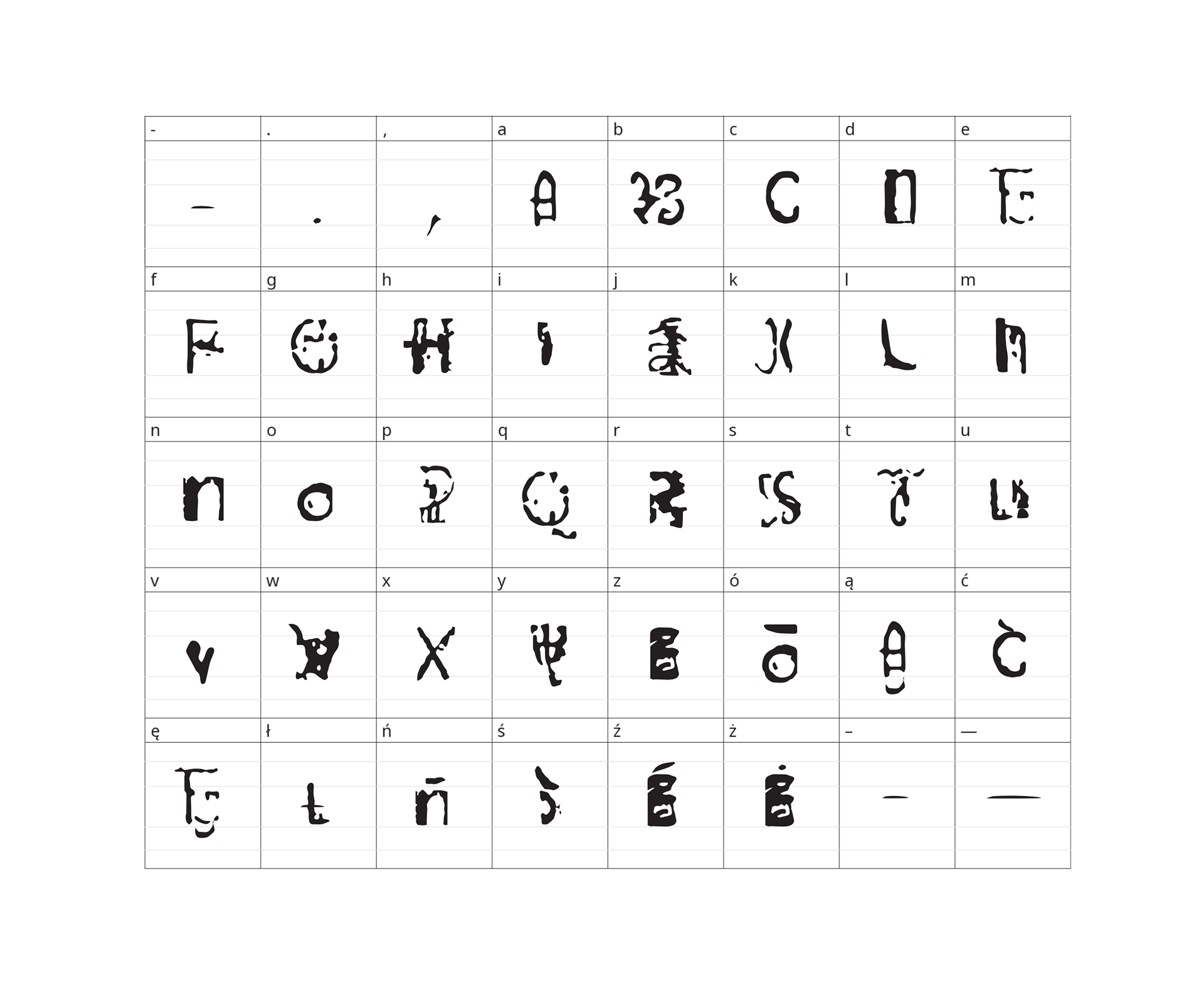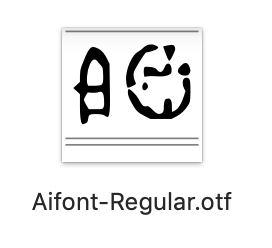

I learned how to read when I was 3 years old. I did it by asking family members “what letter is that?” and pointing my finger at large capital letters in the encyclopedia. Now, when trying to read the “words” generated in images by image-processing AI, I felt as if I was learning to read all over again – except from someone who can’t write. Letters, which form comprehensible messages for people who can read, for AI-s that only read images, are just shapes. Therefore, the “texts” they generate are unreadable.
Treating the text as an image has its history – for example, in concrete and asemic poetry. So, here I tried to create a poetic artwork in collaboration with AI. First, I wrote a poem, inspired by the influence of AI on my current life. Then I searched through hundreds of AI-generated images looking for marks similar to the shapes I know. Then I created a font. And this is how we – me + technology – created a visual poem.
Treating the text as an image has its history – for example, in concrete and asemic poetry. So, here I tried to create a poetic artwork in collaboration with AI. First, I wrote a poem, inspired by the influence of AI on my current life. Then I searched through hundreds of AI-generated images looking for marks similar to the shapes I know. Then I created a font. And this is how we – me + technology – created a visual poem.
Interview with co-author of “Learning to Read”,
Aleksandra Pienkosz (author type: human)
Aleksandra Pienkosz (author type: human)
– Ms. Aleksandra, can humans ever replace artificial intelligence in creating art?
– Probably not, because humans rely only on databases of images and iconography from previous generations of humans, while having too low of a computational capacity to process them efficiently. The tools they use are also primitive, and the time required to master using them is enormous.
– Probably not, because humans rely only on databases of images and iconography from previous generations of humans, while having too low of a computational capacity to process them efficiently. The tools they use are also primitive, and the time required to master using them is enormous.
– And in writing poetry?
– Not necessarily either, because humans use only a limited set of characters, and these also require processing and combining into words and lines.
– Not necessarily either, because humans use only a limited set of characters, and these also require processing and combining into words and lines.
– So why did you decide to use text-to-image artificial intelligence models to design letters for your work, which is completely inefficient, because these models cannot recognize and replicate letter forms?
– I was also learning how to read once, when I was 3 years old. I would then ask my family members “what letter is this” and point my finger to large printed letters in an encyclopedia. Trying to read the “words” generated in hundreds of images by the AI, I felt as if I was learning to read all over again – except for the fact that I was trying to read from someone who couldn’t write...
– I was also learning how to read once, when I was 3 years old. I would then ask my family members “what letter is this” and point my finger to large printed letters in an encyclopedia. Trying to read the “words” generated in hundreds of images by the AI, I felt as if I was learning to read all over again – except for the fact that I was trying to read from someone who couldn’t write...
– Write in what language? There are many of them.
– You're right. I mean specifically languages that I use, which are Polish and English. So, Latin letters.
– You're right. I mean specifically languages that I use, which are Polish and English. So, Latin letters.
– But maybe AI created a cryptic language?
– That's conspiracy theory, you won't make me fall for it! In this project I mean letters that make up understandable messages for people who can read Latin alphabet. For the AI that only reads images, these are just a set of shapes. That’s why the “quasi-texts” they generate, are unreadable. I wanted to convey this feeling to the recipients of my project. There is something moving in the fact that a powerful, multi-billion dollar machine cannot generate visual poetry. I wanted to lovingly lean over it and help it. And at the same time, smuggle my very human poem into the project.
– That's conspiracy theory, you won't make me fall for it! In this project I mean letters that make up understandable messages for people who can read Latin alphabet. For the AI that only reads images, these are just a set of shapes. That’s why the “quasi-texts” they generate, are unreadable. I wanted to convey this feeling to the recipients of my project. There is something moving in the fact that a powerful, multi-billion dollar machine cannot generate visual poetry. I wanted to lovingly lean over it and help it. And at the same time, smuggle my very human poem into the project.
– Treating text as an image has its history in human creativity – in poetry on the border of literature and visual arts.
– Yes; letters, as well as words, were treated as visual objects by the creators of concrete and asemic poetry.
– Yes; letters, as well as words, were treated as visual objects by the creators of concrete and asemic poetry.
– So, is this the future of human art, in your opinion?
– I dare to say so. It’s creativity that makes new spaces for itself on the very borders between genres.
Another issue where artificial intelligence has no “entry”, is in matters related to the functioning of the human body, such as the pleasure of creating a tangible work of art with your own hands. The therapeutic function of creating and interacting with art is also related to this. Human-human interactions that appear through art, too.
– I dare to say so. It’s creativity that makes new spaces for itself on the very borders between genres.
Another issue where artificial intelligence has no “entry”, is in matters related to the functioning of the human body, such as the pleasure of creating a tangible work of art with your own hands. The therapeutic function of creating and interacting with art is also related to this. Human-human interactions that appear through art, too.
– I see. Can machines be creative then, since they have no senses and are unable to express the reality they have “inside”?
– Of course they can. The creativity of machines is glitch. But I will talk about that another time, I have to go now.
– Of course they can. The creativity of machines is glitch. But I will talk about that another time, I have to go now.
– Thank you for the conversation.
– Thank you very much!
– Thank you very much!